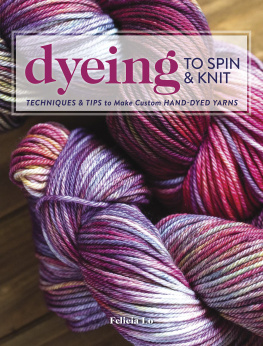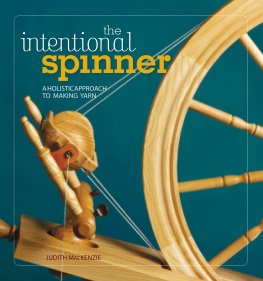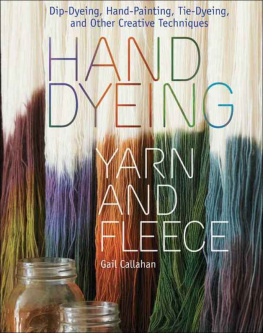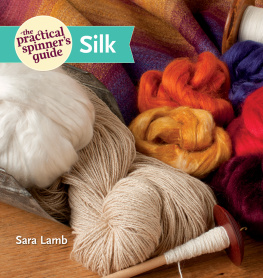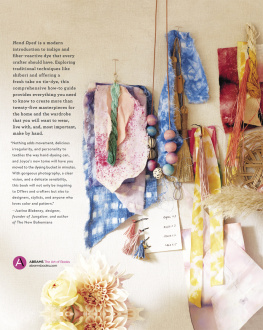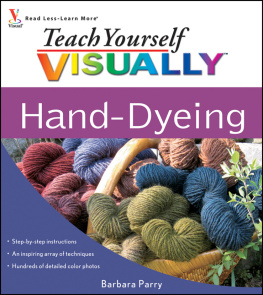Contents
Guide

Felicia Lo

Dedication
For Daniel, Russell, and Ninamy heart and my joy. You are the color in my life.
And also for my parents who always encouraged me to do what I love.
Contents

Introduction
Unapologetic is how I have long described my obsession with color and craft.
Its also a perspective that I try to carry throughout all aspects of my life. To me, its about overcoming the fear of judgment, whether thats from our own self-doubt or the perceived criticism of others. I have often found that knitters and crafters can be sheepish or self-conscious about working with or wearing things made with strong colors, despite really enjoying the depth and vibrancy of those colors. So I hope that this book will help people dive into and indulge in the colors they love.
This book is designed to inspire, ignite, and unleash an unapologetic passion for handcrafted color with clear, comprehensive guidance on how to create and work with hand-dyed knitting yarns and spinning fibers.
Over a decade ago, when I had an itch to explore dyeing, I stumbled upon Lynne Vogels brilliant Twisted Sisters Sock Workbook (Interweave, 2002). The vibrant and cheerful handspun yarns and the simple step-by-step dyeing instructions gave me confidence to explore my own passion for creating color. Since then Ive had the opportunity to document and share what Ive learned through my blog and in classroom and distance-learning settings. My aim in this book is to illustrate many of the techniques that Ive explored over the years in a way that will inspire even more people to begin their own creative journeys.
Throughout these pages, spinners will learn the skills to subdue overly bright colorways and prevent muddiness in their handspun. Knitters will learn the techniques to accentuate or avoid pooling, as well as how to masterfully manage multicolored yarns. Dyers and colorists will be opened to the limitless ways to apply and dye color by hand and will learn to visualize how dyeing affects final fabric, whether its knitted hand-dyed yarn or knitted handspun yarn.
If you are at all curious to try your hand at creating color, I encourage you to step into my dye studio through these pages and find ways to experiment and discover the joys of working with color in yarn and fiber. I invite you to build confidence in your ability to work with color through knowledge and experience so that you might enjoy color to the fullest!
My Color Stories
A color story is a theme or concept around a palette of colors that is often used in fashion, home decor, or design to communicate a central message or idea. Its basically a story told through colors. A color story might be something such as moody blues, wherein all the clothes in the collection are subdued and subtle shades of blue or golden fields, in which all the colors are warm, sun-kissed hues of earthy yellow, gold, and green. People often have a soundtrack to their lives songs that theyve played over and over again at important timesbut Ive had a color story to my life. Its made up of the themes and colors that Ive worn, lived in, and breathed since my childhood.
Easily the greatest color influence on my childhood was my father, who is a painter and printmaker. When I was thirteen, we moved from Toronto to Vancouver so that he could focus on being a full-time artist. My childhood was bathed in color, and from a young age, I recognized that the world contained more than the primary colors of red, yellow, and blue. My world had all the subtle shades, from spruce green to celadon and goldenrod to ochre. Something wasnt just yellowwe learned to describe what kind of yellow.
While my husband remembers being permanently scarred as a child by a classmate telling him he was a terrible singer, I have strong childhood memories about working with color. When I was very young, I had these metal hair clips that came with pink, blue, and yellow ribbon. The idea was that you could wrap the hair clips with the ribbons of your choice. I chose yellow and pink, but was told that those two colors didnt go well with each other. It was confusing to me, and I felt like I had done something wrong. Why didnt they go well? Who gets to decide that, anyway?
Later, in elementary school, my go-to color combination for my outfits was hot pink and red. Again, I was told that those two colors clash and that I should never wear them together. Defeated, I stopped wearing those colors together and instead siloed them and wore them separately so that I wasnt doing anything wrong.
Then early in my high school years, I became obsessed with my mothers copy of Color Me Beautiful, a book about seasonal color analysis. The concept was that by observing your personal coloring (hair, skin, and eye color), you could easily determine which colors were right for you. Being deeply affected by my questionable color sense, I felt like it would be a good thing to figure out what I was supposed to wear. The book was written in the early 1980s and lumped all Asian people into the same classificationWinter (despite the fact that some Asian girls have fairer skin or darker skin, warmer skin, or pinker undertones). Nevertheless, I figured I must be a Winter and assessed my designated color palette. The Winter palette was dominated by mostly boring (to me) dark blues, greens, and grays, plus the occasional purple or plum. But I was excited by a sharp, hot turquoise and a gorgeous chartreuse green.
So of course, on my next shopping trip with my mom, I insisted on buying a pair of bright lime-green cotton pants. They were in my designated color palette. How could I go wrong? I wore these awesome and eye-catching pants to high school, and when I stepped off the bus, the very first classmate I saw sneered Nice pants with a disdainful eyeroll. It was heartbreaking and confusing. Why couldnt I get it right?
From that time on, I began a long-term relationship with the color black. I wore black from head to toe throughout high school with some occasional hits of inoffensive color such as brown or gray.
Theres nothing wrong with black or wearing black other than the reason I was wearing black. It was fearfear of what other people thought of me. Black minimized the chances someone would think I was wearing the wrong color and say, Oh, ewww, what are you wearing?
Since that time, Ive gone through phases where all I wore was black (because its slimming, and you seemingly cant make mistakes with coordinating an all-black outfit) or only gray sweaters (because you can safely hide away behind them). I had always loved color and enjoyed looking at and working with color, but I was too scared to actually wear color. I was too afraid that my color combinations were not right. And I wondered if other people experienced the same thing.
Even now, I get what I call the gray sweater syndrome. When Im going out to somethingan event, a social gathering, whateverand I dont feel particularly confident, I instinctively put on some kind of gray sweater. It could be charcoal or silver, gray-brown or beige... its just a neutral, inoffensive color that I hide behind. And again, theres nothing wrong with dressing in neutrals, but the question is whether youre doing it because it makes you look fabulous, or youre using neutrals as a security blanket because youre intimidated by the possibilities ofcolor.

